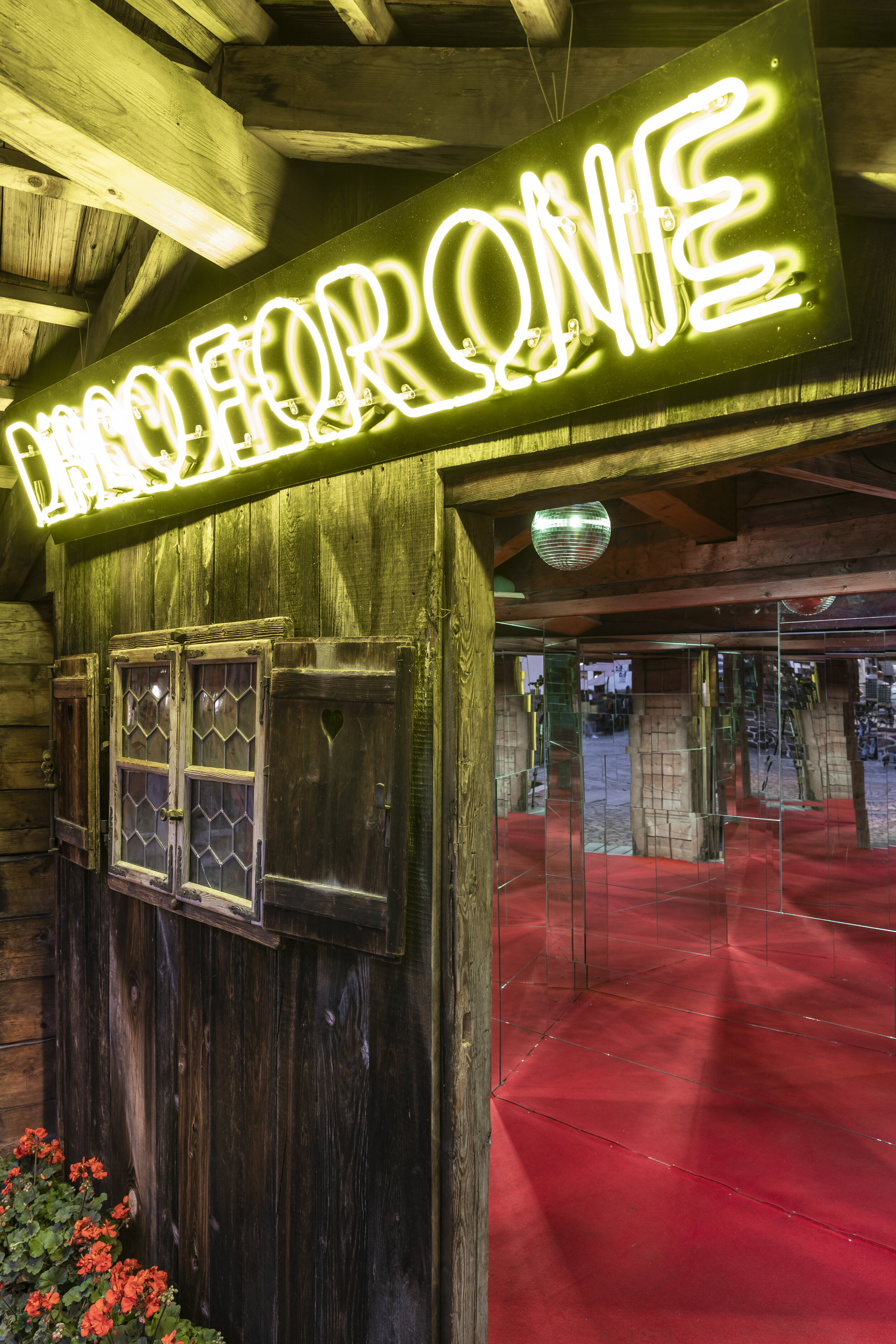
Maria Papadimitriou
*1957, Greece
lives in and works in Athens and Volos, Greece
EN
Maria Papadimitriou(*1957, Greece) is known for participatory projects and collective activities that highlight the connection between art and social reality. Questions of identity, social integration and exclusion are recurring themes in her work.
For the Biennale Gherdëina 7, Maria Papadimitriou created a walk-in sculpture entitled Disco for One as a tribute to Ortisei-based disco music legend and film music producer Giorgio Moroder. A small Alpine hut, a typical architecture of the South Tyrolean Dolomites in miniature format, has been appropriated by the artist and transformed into a haunting room, pervaded by Disco music, open to be enjoyed by a single visitor at a time. Above the entrance to the hut, the neon sign Disco for One encourages visitors to enter. By turning a collective everyday experience, namely collective dancing, into a solitary, self-centred entertainment, Maria Papadimitriou’s project appears prophetic. The current pandemic and the social distancing imposed by it altered our behaviour and the understanding of our social setting. Papadimitriou’s proposal offers a witty alternative and at the same time she draws an ironic, yet perhaps realistic scenario for a possible future of the entertainment industry and of social cohabitation.
IT
Maria Papadimitriou (*1957, Grecia) è nota per i suoi progetti partecipativi e attività collettive che evidenziano la connessione tra arte e realtà sociale. Le questioni dell’identità, dell’integrazione sociale e dell’esclusione sono temi ricorrenti nel suo lavoro.
Per la Biennale Gherdëina 7, Maria Papadimitriou ha realizzato una scultura-cabina dal titolo “Disco for One” (Discoteca per uno), in omaggio a Giorgio Moroder, star della disco music e music producer per il cinema nato a Ortisei. Un piccolo rifugio alpino, tipica costruzione delle Dolomiti altoatesine in formato miniaturizzato, è stato trasformato dall’artista in un ambiente immersivo dedicato alla disco music e offre lo spazio per un visitatore alla volta. All’ingresso del rifugio campeggia l’insegna luminosa “Disco for one” che invita i visitatori a entrare. Cambiando le abitudini e proponendo una versione solitaria di una forma di intrattenimento normalmente percepita come esperienza collettiva, il progetto di Maria Papadimitriou appare oggi profetico. La pandemia attuale e il distanziamento sociale che ne consegue hanno modificato i nostri comportamenti e il nostro rapporto con le norme sociali. Papadimitriou offre così un’alternativa scherzosa e allo stesso tempo disegna uno scenario ironico ma forse realistico per un possibile futuro per l’industria dello spettacolo e per l’aggregazione sociale.
DE
Maria Papadimitriou (*1957, Grichenland) ist bekannt für ihre partizipatorischen Projekte und kollektiven Aktivitäten, die die Verbindungen zwischen Kunst und gesellschaftlicher Realität hervorheben. Fragen nach Identität, sozialer Integration und Ausgrenzung sind in ihrem Werk wiederkehrende Themen.
Für die Biennale Gherdëina 7 konzipierte Maria Papadimitriou unter dem Titel „Disco for One” eine begehbare Skulptur als Hommage an den aus St. Ulrich stammenden Giorgio Moroder, seines Zeichens legendärer Musikproduzent der Disko Ära und Komponist berühmter Filmmusiken. Eine kleine Almhütte, entsprechend der typischen Architektur der Südtiroler Dolomiten im Miniaturformat, wurde von der Künstlerin zu einem eindringlichen, von Disco-Musik durchdrungenen Raum adaptiert, der jeweils nur für einen Besucher zugänglich ist. Die Leuchtreklame „Disco for One”, auf der Dachgiebelfront der Hütte, ermuntert die Besucher dazu, einzeln einzutreten. Indem die Künstlerin eine kollektive Alltagserfahrung, nämlich jene des kollektiven Tanzens, zu einer auf sich bezogenen, solitären Unterhaltung verkehrt, wirkt das Projekt von Maria Papadimitriou prophetisch. Die gegenwärtige Pandemie und die dadurch notwendig gewordene soziale Distanz haben unser Verhalten und das Verständnis unserer sozialen Umgebung verändert. Papadimitrious Vorschlag bietet in diesem Sinne eine witzige Abwechslung und gleichzeitig zeichnet sie ein ironisches, aber vielleicht realistisches Szenario für eine mögliche Zukunft der Unterhaltungsindustrie und des sozialen Zusammenlebens.



